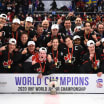From March 12-18, the NHL and its member clubs, as part of the first NHL Green Week, have showcased greening programs and initiatives that are reducing the League's environmental impact, while calling on fans and partners to accelerate a movement toward a healthier planet.
One of the main focuses has been clean water conservation.
NHL arenas are using water more efficiently, from waterless urinals at Staples Center in Los Angeles to reverse osmosis water filtration systems at MTS Centre in Winnipeg.
Since 2011, the League has restored approximately 50 million gallons of fresh water to rivers and streams in North America through its partnership with Bonneville Environmental Foundation.
"I'm so incredibly proud of the NHL because they haven't shied away from the issue, they've embraced it while reaching an audience the EPA can't really reach," McCarthy told NHL.com. "They make it real for people. It isn't just about some far-off drought problem, it's about whether we can take our kids skating anymore. There are all kinds of implications that aren't just about polar bears, but it's about our kids and the joys we get from sports and other recreational activities.
"We had a lot of ponds in the area. Those aren't particularly around anymore the way they used to be."
Water conservation is just one area of the NHL's focus. The League, through energy partner Constellation, has implemented other initiatives to reduce its carbon footprint -- which it has offset two years in a row -- by using more environmentally friendly technologies, including LED lighting, heating and cooling systems, composting and recycling.
The League is the 20th largest user of green power in the United States, according to the EPA's Green Power Partnership.
McCarthy is hopeful other professional leagues follow suit.
"Obviously people in pro sports are very competitive, so let's get them juiced up," she said. "Ask them, 'If the NHL can do it, why can't Major League Baseball or the National Basketball Association or the National Football League?' Let's get everybody engaged, because that gives us a tremendous message of, 'We're all in it together, they don't need to be afraid and we can all take action.' Who wouldn't want to do that? Why isn't that an overall good everyone can embrace?
"I'm excited the NHL can be an example to hold out there. If we hold it out there long enough, everyone else will ask questions why other leagues aren't standing with them."
Though the League and its member clubs are taking these initiatives to improve the environment, that doesn't mean NHL fans can't help as well.
"The real danger and the real economic problem we face is not taking action," McCarthy said while speaking at the 2015 American Meteorological Society meeting in Phoenix.
McCarthy said everyone can make an impact. The EPA provides suggestions people can follow in an effort to help combat climate change and improve the environment.
"Let's get everybody active in their own homes and own communities," McCarthy said. "Then it takes off and takes on a level of magnitude that can't be stopped."

















